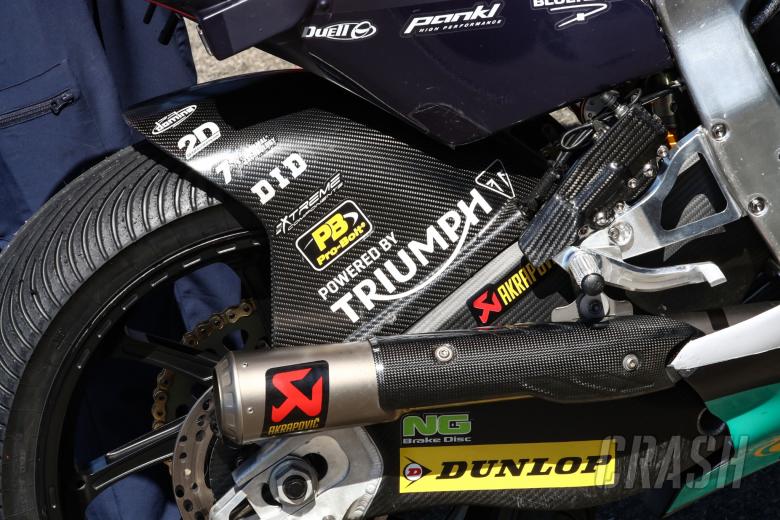Triumph to focus on Moto2, MotoGP ‘a whole different ball game’


When it became clear that only a new manufacturer would be eligible to take over the Suzuki MotoGP grid slots, Triumph was spoken of as a possible candidate alongside the likes of BMW and Kawasaki.
The British manufacturer already has a presence in the grand prix paddock courtesy of its exclusive deal as Moto2 engine supplier, which began in 2019 and has been extended until at least 2024.
But was Triumph ever tempted by the surprise MotoGP opportunity?
“Well, I mean in terms of budget, that is a whole different ball game,” Triumph chief product officer Steve Sargent told Crash.net.
“And it's not really just about the budget to actually go racing, it's about the amount of R&D spend and the R&D effort that has to go in behind that.
“So our focus at the moment is on Moto2, Supersport and going into Motocross and Enduro.”
- Keith Huewen: My rider of the year? It can be only one person…
- Norick Abe’s son gets World Supersport seat for 2023
- Valentino Rossi becomes BMW M Motorsport ‘works driver’
What does Triumph get from Moto2?
The grand prix classes feature exclusive technical suppliers in areas such as tyres, fuel and electronic components, but Moto2 - which replaced 250cc in 2010 – is unique in using a single engine supplier.
Lightly-modified Honda CBR600s powered the Moto2 grid from 2011 to 2018 before Triumph arrived in the paddock with its 765cc triple. So what was the attraction?
“Our expectation was to demonstrate what Triumph is capable of as a company, particularly as an engineering and R&D capability,” Sargent said. “I think a lot of people know Triumph historically as maybe a bit more of a classic bike brand, but quite clearly we have other segments that we're also very actively involved in.
“It was about trying to create awareness of what we're capable of in terms of developing performance engines and the reliability of the engineering that sits behind it. Moto2 is really a great opportunity and a great vehicle for being able to do that.
“In countries where MotoGP is very popular - Southern Europe, Indonesia for example - the awareness of Triumph as a brand has increased significantly from our involvement in Moto2.
“At the end of the day, what we really want to do is sell more motorcycles. I think Moto2's done us a lot of good. “
It’s not only new customers that Moto2 has helped attract to the Triumph brand, but engineers.
“We do now get quite a lot of engineers applying to work at Triumph who have said, ‘the reason I've applied is because I've seen you in Moto2, I'm a race fan and I want to get involved in that kind of thing’,” Sargent explained.
“Or they might also have heard about us going into off-road, Motocross and Enduro.
"[Racing] definitely does attract people to want to come and work for you.”
‘If you want to test your engineering, put it in the hands of Moto2 riders!’
In terms of the technical benefits, Sargent said there is nothing like putting your engines in the hands of 30 of the world’s fastest up-and-coming riders.
"I think quite honestly there's no other class in motorcycle racing where you get the opportunity - but also the risk! - of being able to demonstrate that you can put a competitive race engine out there, to be used by so many different riders and teams, and prove to be reliable," Sargent said.
“With all of our road bikes, we do quite a lot of track endurance testing using current and ex-British Superbike riders. They're all good riders. But they’re not riding as hard as these [Moto2] guys, I can tell you that!
“If you really want to test the robustness of your engineering, put it in the hands of these Moto2 guys, who are desperate to prove that they're capable of being MotoGP riders.
“If anybody's going to push it to the absolute limit. It's these guys.”
Taking the engines well beyond their ‘street’ limits for lap after lap gives Triumph valuable real-world data.
While the production 765cc engine has a rev limit of 12,650, which was raised to 14,000 RPM for the Moto2 race version, the revs get much higher when exposed to a careless downshift.
“We're seeing the engines being quite heavily abused, overrevved to 15,300, and that's something we never see on a road bike,” Sargent said.
“So one of the key things for us is that when the engines come back after every three rounds to be stripped down by Trevor [Morris, ExternPro], are there any components that are having more wear than we expected? Are there any components in the engine that might be fracturing or anything like that?
“But I'm sure Trevor will back me up in that generally every single engine that gets opened looks brand new.”
While spotting signs of weakness or wear during an engine rebuild has obvious R&D benefits, Sargent explained how Triumph also learns from the ‘brand new’ parts.
“When we design engines, we do a lot of theoretical calculations about the stresses that are going into certain components,” he said. “But at the end of the day, those calculations are only as good as the [numbers] that go into them and so there always has to be a safety factor included.
“Using the new Street Triple that we launched [at Valencia] as an example, saying to the engineers ‘we want to go from 123 to 130 PS’. They might have said, ‘I think that takes us into our safety factor’ for a certain component.
“But we could show it’s the same component that we've been using in Moto2 for the last three seasons, that we know can live to over 15,000 RPM on a regular basis with no issues.
“So all of that helps go back into road bike development. It’s also the same team that does both the road bike and the Moto2 engines. We don’t use a separate race department.
“That means a lot of what we learn not only helps us think about where we want to take the Moto2 engine next but how much of that can we also bring into the standard Street Triple.”
The highest top speed recorded by a Triumph Moto2 engine is 301.8km/h by Stefano Manzi at the 2019 Australian Grand Prix.
With no replacement found for Suzuki, the MotoGP grid will shrink from 24 to 22 places next season.



